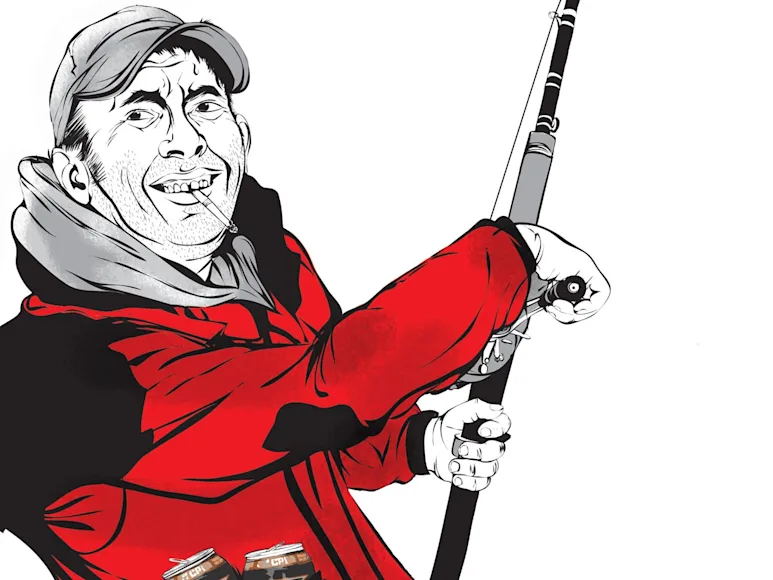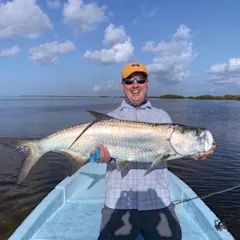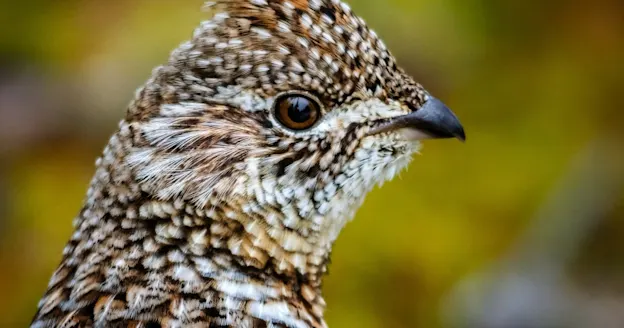One. I cast a jerkbait. Nine inches long, 3 ounces, and with two 3/0 treble hooks, the lure sails 40 yards before it belly-flops on the lake surface. I point the rod at the water, reel in the slack, and let the bait sink. The lure throbs, rocks, and streaks as I work it back to the boat, pumping the rod every couple of reel cranks. When no strike comes, I fire my second cast. Two.
It’s a late afternoon in June, and I’m casting blind to muskellunge, the fish of 10000 casts, just outside Hayward, Wis.—the Muskie Capital of the World and home to the all-tackle world record. Three. I don’t know the name of the lake, and my guide, Scott Kieper, has told me not to ask. It’s a small lake—small enough for Kieper to refer to it only as the Pond. With the exception of one kid who is trolling on his own, we’re the only ones fishing. Kieper hopes to keep it that way. Four.
About an hour earlier, Kieper and his buddy Guy Mittlestadt, who helps Kieper film and produce muskie fishing DVDs, picked me up at my motel. Before I arrived in Hayward I had seen photos of Kieper on his website, but in person he looks different. He’s thinner than I’d expected, and a bit pale. He looks as though he could use a hearty meal and a long night’s sleep. He looks unhealthy—almost like a junkie. Which he is. It’s just that Kieper’s drug is muskellunge.
“Muskies cause more broken homes, divorces, and lost jobs,” says Kieper, 37. “But I got dogs. What more does a man need? And they’re German shorthairs, so they’re as smart as most people anyhow!”
Kieper feeds his muskie fix by logging long hours on the water. His season starts Memorial Day weekend and ends when the lakes freeze. For five months he hunts muskies every single day. A typical trip lasts 10 hours—longer if the bite is hot—and he and his clients often fish deep into the night, sometimes until first light. “If the fish go nocturnal, we go nocturnal,” he says. Working the graveyard shift night after night, it’s no wonder that Kieper has trouble maintaining a suntan—or a nutritious diet. “I basically live on nicotine, energy drinks, and Sour Patch Kids. I’m a bag of skin on a skeleton.”
When you fish as hard and often as Kieper, you’re bound to run into big muskies—lots of them. In 2008, Kieper and his anglers released 243 muskies. Forty-six were bigger than 45 inches, and eight broke the 50-inch benchmark. And now, in the first month of the 2009 season, he is off to one of the best starts of his career: 67 fish. He’s netted 11 muskies over 45 inches and three over 50, including a 53-inch, 40-plus-pound giant that he caught today before dawn, literally hours before he pulled into the motel lot to pick me up. No wonder he’s got a reputation as the expert when it comes to finding the fish of 10000 casts.
Just a few minutes into our drive to the Pond, I start to understand how Kieper is able to work such a grueling schedule: The guy has no off switch. He’s loud. He’s hyper. He’s very, very happy. One question is enough to spark a stream-of-consciousness soliloquy that might jump from the predatory nature of the muskellunge to the economy to Ben Franklin. As I struggle to take notes at the rate of Kieper’s rants, a part of me begins to doubt if I can keep up with this character for two days of what I’ve been warned will be almost nonstop fishing.
“With muskies, it’s about the hunt,” Kieper says. “It’s about the chase—the fact that you’re up against the king of freshwater. And it’s about the dedication of yourself to the fish in order to succeed. You have to be willing to commit to it to attain that success.”
Later, as I stand at the bow of Kieper’s 18 1⁄2-foot Lund anchored in the Pond, I commit myself to the long hunt ahead. And I cast.
The Fish of 10000 Casts Challenge Begins
I’ve never fished for muskies, let alone caught one. Before the trip I decided that I’d conduct an experiment: How many casts does it actually take to catch the fish of 10000 casts? To help me keep count, I have a clicker inside my jacket pocket, the same kind baseball managers use to track pitch counts. The clicker goes to 9,999—not that I’ll have time for that many casts in just two days. But for as long as I am here, I will make one click for every cast.
Five. Kieper is at the stern casting, keeping one eye on the fishfinder and one on a rod rigged with a live 20-inch white sucker that he set 14 feet deep. Mittlestadt has the camera ready in case a monster strikes. Six. I’m using a 9-foot Musky Innovations rod and an Abu Garcia 7000i C3 musky reel spooled with 80-pound Cortland Spectron line. Seven.
At the end of each retrieve—when the ball-bearing swivel that connects the line to the wire leader is a few inches from the rod tip—I adjust my grasp on the rod and hold it like a broom, then I plunge it in the water and sweep the rod and trailing lure in a figure-eight pattern. It’s hard for me to believe that a fish so notoriously finicky as a muskie could be duped like this so close to the boat. But it happens a lot—to big fish, too. Getting a muskie to shadow the lure to the boat is one thing. Getting it to eat is another. But Kieper has a couple of tricks to make the figure eight more appetizing.
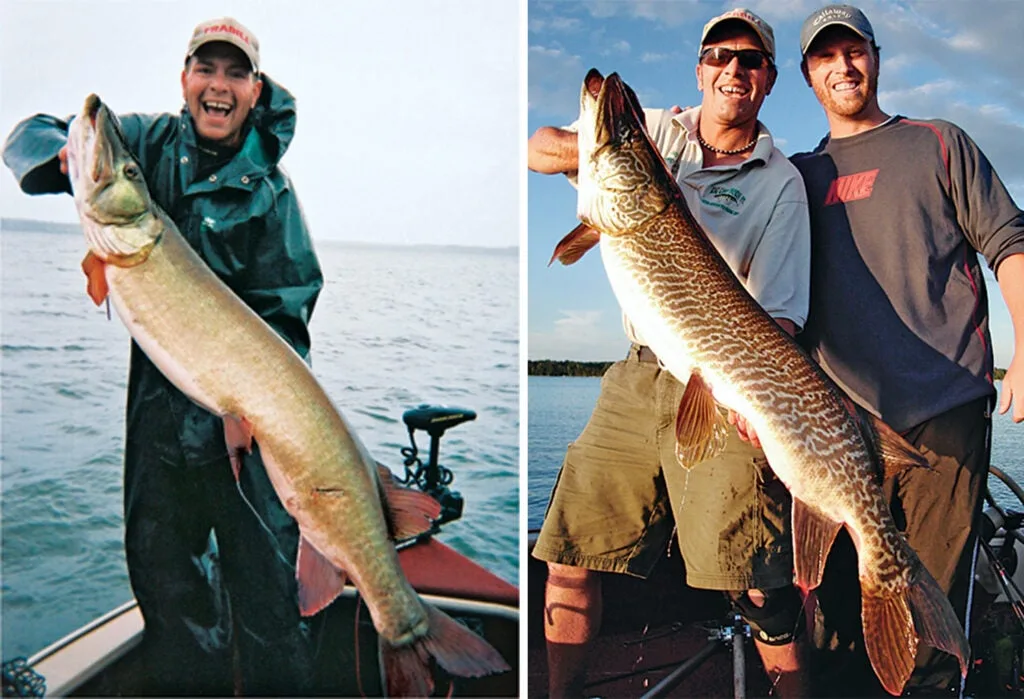
Here’s how some of Kieper’s best fish measured up. From left: 53 inches, and a 49-inch hybrid. (Courtesy Scott Kieper)
First, get the bait deep: “Most of the fish that you’re going to get at boatside are going to come out of nowhere,” he says. “If you don’t have that rod down 18 inches to 2 feet, you’re not going to have that bait deep enough to entice the fish. The muskie isn’t a surface dweller by nature, and it doesn’t want to have to come up to the gunnel.”
Second, make sure the turns in the eight are w‑i‑d‑e: “A muskie can’t turn on a dime,” Kieper continues. “The No. 1 law of predation is that you expend less energy than you consume. Otherwise you starve. So if you force a muskie to move its body harder than it wants to by making a lazy, tight turn at the end of the figure eight, the fish is going to give up on you.”
Kieper’s figure eight is aggressive and precise. It’s work. After a couple of hours, the temptation to get lazy on the occasional figure eight settles in. When that happens I remind myself that some of Kieper’s biggest muskies were caught at this point in the retrieve, including this morning’s 53-inch trophy. And even that fish needed plenty of convincing: Kieper had to make 25 consecutive figure eights before he tricked the fish.
“It’s all about the extra work you put into every single little thing on every single day with everything you do on the water,” Kieper says. “Otherwise, when that one chance on that one day comes, it’s going to be the one moment when you’re not prepared. That nanosecond can be when a 50-pound fish of 10000 casts comes out of nowhere and blasts you.”
Seventeen…32…48…I’m in a routine now. Cast. Retrieve. Figure eight. Cast…
I fan my casts across the bow at different distances to cover as much water as possible. Fifty-nine. I work the lure back. And there’s a tug. I set the hook and the line comes tight. Kieper puts his rod down, and Mittlestadt readies the video camera. I dig the rod butt into my waist to prepare for the fight—but there isn’t any. The fish pretty much skips across the surface as I reel. And the fish isn’t a muskie. It’s a small pike. After Kieper releases it, I check the lure and cast…60.
We ease our way around the Pond, and I keep casting…88. Occasionally Kieper notices a promising spot on the fishfinder, and we stop to investigate…103. But as the afternoon fades he opts for a change of venue, a nearby spot he calls Lake Opposite…111. There he says we’ll cast a bit longer, and then troll all through the night…137. Trolling isn’t how I’d hoped to catch my first muskie. But, I’m learning, with this fish, you can’t be picky.
Kieper jumps the boat on plane, and as we race back to the access area the cold wind slaps my face. With the sun starting to set, the temperature is dropping fast. I’ve unfortunately timed my trip with the arrival of a severe cold front—nature’s way of forcing fish to go on a hunger strike. I zip my jacket to my chin and brace myself for tonight’s long, dark hunt.
Fishing for Muskies at Night
At 9:30 p.m. I launch my last cast of the day, 181. If I’m going to catch the fish of 10000 casts tonight, it won’t be from casting; it’ll be on the troll. The sun has fallen behind the pine and birch trees that encircle the lake, but enough light remains for Kieper to prepare the trolling spread. As he rummages through his lures and clips the planer boards to the rigs, he is downright giddy about the night’s prospects. “I love it! I love it! I love it!” he says of Lake Opposite, which we have completely to ourselves. “Everyone’s afraid of my water.”
Every lake has its own ecology, Kieper says. And in some lakes—whether because of clarity or depth or forage—the big fish feed best in the worst conditions, such as a cold front. Over the years, Kieper has learned that Lake Opposite is one of these lakes. “It’s a lake that proves under the most adverse fishing conditions, it will still have fish that put themselves in the net,” he says. “But nobody knows that. It’s a lake that you’re not supposed to fish unless it’s brutally nasty out. When most guys are fleeing in the opposite direction, Lake Opposite can be on fire.”
Chow on the boat is whatever you brought with you. Mittlestadt polishes off a bag of pork rinds. I inhale a Snickers and two granola bars and wash them down with my third Red Bull. Kieper skips dinner but smokes. He does offer to share dessert: his 2-pound bag of Sour Patch Kids that he stashes in one of the boat compartments. Mittlestadt eats a few handfuls before he settles down on the bow deck and nods off.
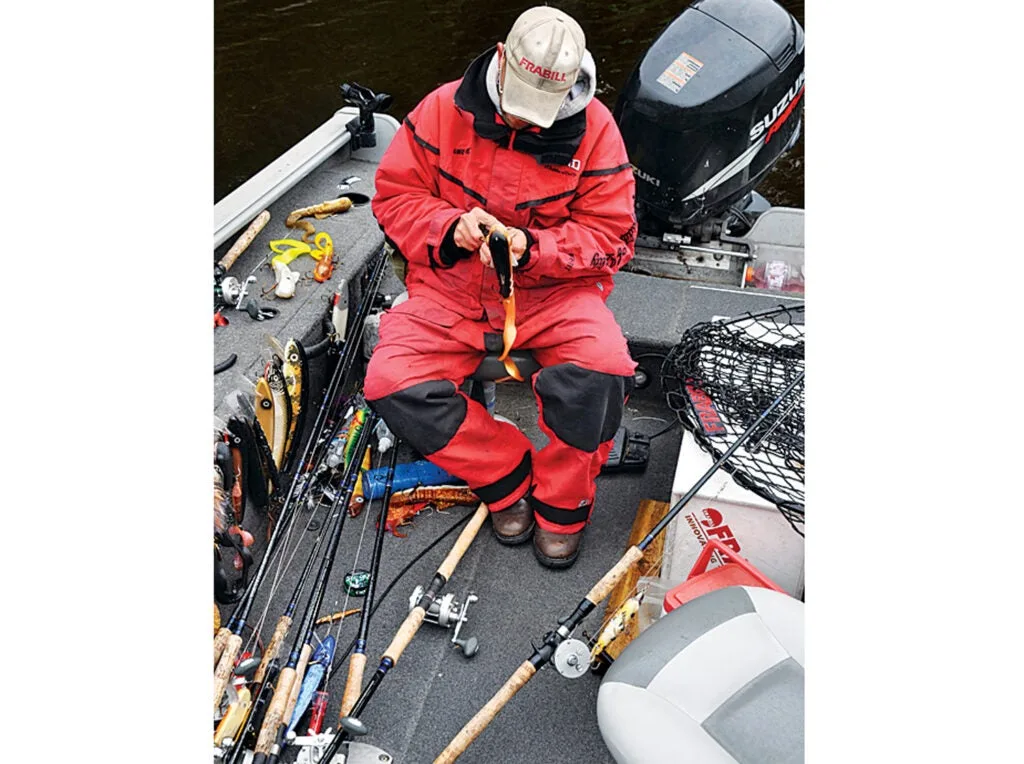
Kieper readies a rod with a Bulldawg jerkbait. (Photo: Colin Kearns)
With six crankbaits in the water, Kieper methodically rakes the lake in laps as he steers the boat at 2.9 to 4 mph. “There is a ton of water for these fish to hide in,” he says. “One fish per 5 acres is almost high density. It’s like searching for a needle in a haystack. I just study the water and the fish and hope to minimize the size of that haystack.”
In these waters, muskies are at the top of the food chain, but Kieper targets them from the bottom end. His approach to hunting muskies is scientific. “Everything in the food chain and the biological surroundings of a muskie dictates what the fish is going to do on any given day,” he says. “So understanding the biological equation is the key to finding the fish.”
In his quest for the solution, Kieper has learned to look in spots that his competition doesn’t—like Lake Opposite in harsh weather. While most muskie anglers focus on structural elements, like rocks, sunken timber, or vegetation, Kieper searches in deep, open water. He says the traditional thinking of where muskies live has underestimated the greater ranges of the fish, and how much it varies over the course of a season.
“My primary concern is never structure,” he says. “My primary concern is forage. Wherever there is food, there is your top-end predator. Wherever that food chain is most active and that preferential forage is in place, that’s where that predator will be.”
As we loop around Lake Opposite, Kieper has his eyes glued on the fishfinder for any sign of forage. He’s paying particularly close attention to the swarms of benthic (bottom) larvae. At night, as the zooplankton descends to the lake bottom, the benthic larvae rises and becomes the main food source for panfish and other juvenile fish, which become the main food source for muskellunge.
The fishfinder is almost like an electrocardiogram for me. When the screen shows a wavy line of forage, I’m excited and awake. When there’s nothing, it reads like a flatline and my eyelids grow heavy. It’s a quiet night. When Kieper and I aren’t talking, I hear only the hum of the outboard, the occasional loon wail, and Mittlestadt’s snoring.
I keep hoping a violent strike will break the silence. I keep picturing that moment.
“When things are slow, you tell yourself you’re going after that one fish,” Kieper says. “You’re hunting for that one big fish.” I keep telling myself that my first muskie is out there.
At 1:05 a.m. Kieper changes the trolling spread with shallower-swimming lures. He puts out three big ones and three small—but a “small” lure for Kieper is still pretty big. The lures in his arsenal run 7 to 16 inches long, and he’s currently working with a manufacturer to develop some custom 20-inch crankbaits. His preference for big baits goes back to his belief that a top-line predator will expend as little energy as necessary for the greatest reward. If a muskie has the choice between one big, easy meal or working to find several smaller bites, Kieper thinks it’ll always go for the easy feast.
“We catch 15-inch walleyes on 15-inch lures all the time,” he says. “A lure that size is nothing for a 36- to 45-inch muskie to grab. What we find is, the bigger the baits that we put on, we’re not catching less muskies. But we’re catching more big ones.”
Big baits are also a way for Kieper to be different. “I’m using bigger baits than 95 percent of the rest of the muskie community,” he says. “Fish aren’t used to seeing stuff as big as what I’m throwing or trolling. They don’t associate my lures as lures because of the fact that they are so grotesquely large.”
Tonight, however, no lure looks tempting enough to make any muskies bite. The change in pressure from the cold front is too much. We troll until 4 a.m. before Kieper brings in the spread for good. It’s around 5 a.m. when Kieper and Mittlestadt drop me off at the motel. I stagger out of the truck and wave good-bye. “See you tomorrow,” I say.
They both laugh. “No, man,” Kieper says. “I’ll see you this afternoon.”
I smile and nod, but at the moment I’m too beat to understand. “Right. I’ll see you tomorrow.”
Kieper laughs again. “Get some sleep.”
The Muskie Hangover
I feel as if I’ve slept for five minutes when my alarm buzzes at 11 a.m. Shortly thereafter my cellphone rings. “Hello?”
It’s Kieper: “Welcome to the life of a muskie fisherman.” He tells me to meet him at a gas station a few miles down the road. Today, we hit the river.
One eighty-two. It feels good to cast again. Kieper has us positioned just below a dam, and he wants me to cast as close to the structure as possible. I work the lure just as I did at the lakes yesterday, only faster, and finish with a deep, wide figure eight. One eighty-three. Kieper says he made the decision to come here last night. After we failed to catch any of the last remaining fish that might still have been active despite the change in pressure, he resolved to fish the river system because it’s been his experience over the years that the fish in moving water usually aren’t as hesitant to feed on the days following a cold front.
I swap lures, trading one jerkbait for another in a different color…213. Kieper swears by these lures from Musky Innovations (muskyinnovations.com)—partly because he’s a member of their pro staff but also because they’ve been good for business. The only lure I’ve cast is a Bulldawg, a soft-plastic jerkbait that rocks back and forth on the retrieve while its curly tail waves frantically. It’s widely considered to be one of the best musky lures
. Kieper loves this lure so much that he got a tattoo of one that stretches across his upper arm and onto his shoulder.
Not surprisingly, Kieper likes the Bulldawg because it’s big and different. “It doesn’t have the plop-plop, the buzz-buzz, the spin-spin, or the wobble-wobble of a lot of muskie lures,” he says. “It doesn’t present itself as a lure.”
What the Bulldawg does do is exploit the one thing the fish of 10000 casts relies on most as a predator: its lateral line. As the bait moves it displaces more water than smaller lures, creating vibrations that a muskie associates with an easy meal. And the Bulldawg’s soft, chewy body gives it another advantage. “Most muskie baits are hard plastic or wood or have metal,” Kieper says. “With a Bulldawg, the fish have a greater tendency to hit and hang on because of the fact that it is rubber and their teeth sink into it. It feels like flesh.”
Two forty-one. I continue to pepper the dam with casts for about two hours. When no fish strikes, Kieper tells me to reel in so we can trailer the boat and put in at another section of the river.
It’s after 3 p.m. when I make my first cast in this part of the river…256. There’s another dam here and I drill it with casts…263…275…287… Kieper also has me hitting the aprons adjacent to the main river channel and the rocky structure along the edges. Two ninety-nine…313…321…
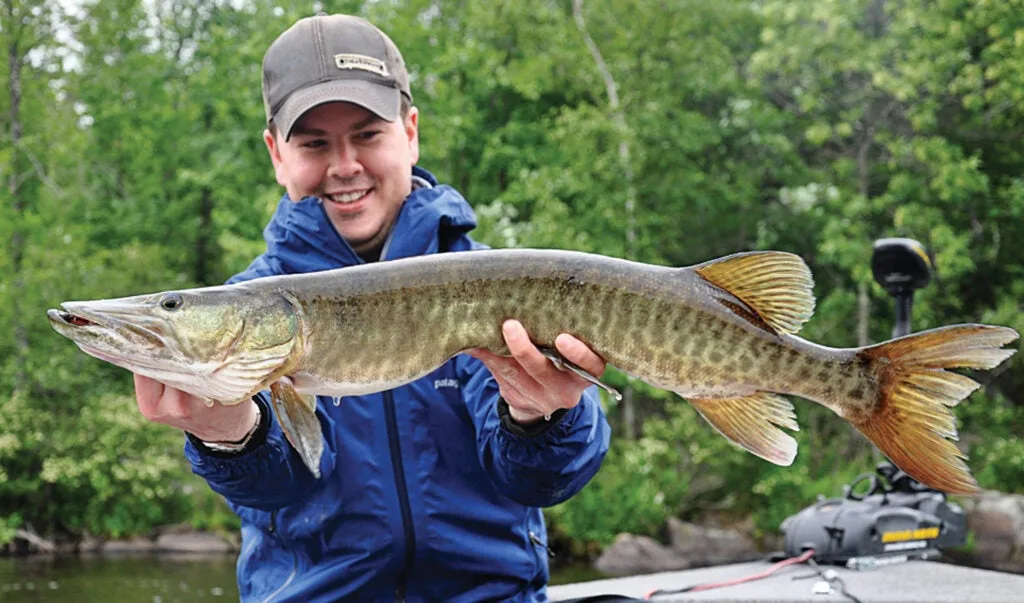
The author with his muskie—9,662 casts under par. (Photo: Colin Kearns)
Three twenty-nine. The casts are shorter and precision matters more here…330. With the current and the tight targets, the fishing is more challenging…331. It’s more exciting…332. I don’t feel as if I’m casting blind like at the Pond…333. I can’t see any muskies, but the layout of the river is such that I feel like I’m casting at fish…334. I know they’re here…335. Kieper motors us about 200 yards downriver from the dam…336. He has his back to me and starts lobbing casts off the other side of the boat…337. I toss a short cast at the bank…338. When my lure hits the water, it’s met with a wild splash. The line comes tight on its own. Kieper doesn’t even have to turn around. He knows.
“Congratulations,” he says calmly. “You just caught your first muskie.”
The fish is no more than 15 feet from the boat, and it doesn’t take me long to reel it into the net. Kieper removes the hook, then shows me how to handle the fish properly for a photo. This fish of 10000 casts is hardly huge—less than 30 inches—but that hardly matters. I’ve been at this for about 16 of the last 24 hours, and in these conditions—hell, in any conditions—anyone who is fortunate enough to catch one of these predators only to be disappointed by its size isn’t deserving of the moment. As I cradle the fish, admiring its teeth, eyes, and color, I forget about the casts, the long, cold hours of hunting, and the exhaustion. I’d spend a week on the water for this fish. For the fish of 10000 casts, I’d cast 20,000 times.
After I release the fish and just before I cast again, I see that it left me with an added, albeit temporary, memory: The knuckles on my left hand are bleeding. I dip my hand in the river to wash off the blood, then I cast. I stop counting.
Final Chance a the Fish of 10000 Casts
“Son of a!” Kieper shouts inside his pickup.
We’re approaching the access area at Lake Opposite, but the parking lot is clogged with trucks. The anglers have just gotten off the water after chasing the fish of 10000 casts and are loading their trailers. Kieper pulls to the roadside and turns off his truck. He’s worried about being recognized and tipping the fishermen off to one of his best nighttime lakes. His anger, which borders on rage, is almost theatrical and a part of me wonders: Is this fit really necessary? When the trucks start to file down the road, Kieper covers his face with his hat and ducks beneath the windshield.
So do I. I don’t mean to, but I just do. In spite of my cynicism, I’ve been with Kieper long enough now that I let myself enter his world and the adventure he’s created. This is all part of the hunt, and it’s exciting.
Once we’re on the lake, we troll. And troll. I stare at the fishfinder, but it reveals even less than last night. It reads as a flatline, and after a couple of hours I don’t have much life left in me. But Kieper does. He continues to tweak the spread and maneuvers the boat around the lake. He’s still focused, still confident. “We’re going to catch something big tonight,” he says. “I can feel it.”
So can I. I can’t say why, but I just can. I’m exhausted and cold, but I want to keep fishing. That’s when it dawns on me: What makes Scott Kieper such a great guide isn’t just his innovative tactics or his ability to think like a predator. It’s also the strength of his enthusiasm and his confidence and how that strength rubs off on the anglers with him. Kieper gets me to believe that I’m going to catch another muskie and that it’s going to be a trophy. For the rest of the night I’ll keep telling myself: You’re gonna catch something big. So be ready.
And even though I won’t catch the fish of 10000 casts, I don’t know that now. I won’t know that until Kieper stashes away the Sour Patch Kids and hauls in the spread at 2 a.m. Until then, I’ll keep watching the fishfinder and listening to the lake. I’ll keep waiting for that strike.
It’s a moment I’ve envisioned a lot the past couple of days. More times than I can count.

